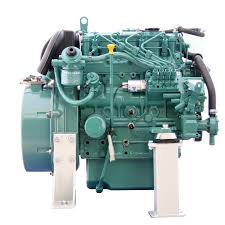Методическое пособие для студентов iv курса очного и заочного обучения специальности 26. 05. 07 "Эксплуатация судового электрооборудования и средств автоматики"
 Скачать 1.06 Mb. Скачать 1.06 Mb.
|
UNIT II. D.C. GENERATORS 1. Read and remember the following words and word combinations.
2. Read and translate the text. D.C. GENERATORS D.C. generators are provided with the armature winding and one of the two field windings. Depending on the type of the armature winding and field winding interconnection D.C. generators may be recognized as those of separate excitation, of shunt excitation, of series excitation, and of compound excitation. In a separately excited generator, the field winding obtains its supply from a separate current source. It is connected in series with the armature winding in a series-wound generator and in parallel - in a shunt-wound generator. A compound-wound generator has two field windings positioned on the main poles, one of them being connected in shunt, the other - in series with the armature winding. The parallel field winding concentrates the current ranging from 1 to 6% of the rated armature current. It is made from copper conductors provided with a large number of turns of relatively small section. The series field winding carries the entire armature current and hence its conductors are of large section. Shunt-wound generators, series-wound generators and compound- wound generators are self-excited; that is to say they don't require a separate current source for their excitation. The current supplying the windings is derived from the generator armature. Practically all D.C. generators installed on vessels for supplying auxiliary power are of the self-excited type. Shunt-wound generators are usually used as the exciters of separately excited generators and have the added feature of charging accumulative batteries. The latter is associated with the fact that with a reverse current they aren't remagnetized in view of the unchangeable current direction in the field winding. Series-wound generators have the voltage which varies abruptly with the load and, therefore, this type of D.C. generators is not used on board ships. Compound-wound generators are not subject to frequent overloads and short-circuit, for the series field winding demagnetizes them. They are employed in welders as well as in some electric drives on the voltage-control system. Separately excited generators find application where a wide- range voltage regulation is required, that is in the electric drives of steering gears, windlasses, winches etc. as well as in the electric propulsion plants as main generators and exciters. When putting D.C. generators in parallel operation, it is necessary that two conditions be met: 1) their polarity should be the same as the one in the mains to which they are connected; 2) their e.m.f. is required to be equal to the mains voltage. The device responsible for fulfilling the indicated conditions is a voltmeter of a magnetic electric system. In order to transmit the power from one generator operating in parallel to another, the excitation currents of the generator to which the power is transferred, should be increased but those of the generator from which it is collected, should be reduced. The generators are required to be loaded as uniformly and proportionally to their rated capacities as possible. If this condition is not fulfilled, the efficiency will be lower. 3. Match the following English and Russian word combinations. a) to vary abruptly,tocharge accumulative batteries,to be subject to, frequent overloads,short-circuit, find application, to fulfill the conditions b) частые перегрузки, находить применение, короткое замыкание, выполнять условия, резко меняться, быть подверженным, заряжать аккумуляторные батареи. 4. Put auxiliaries into each gap. is are do does 1. . . . D.C. machines identical in construction? 2. What parts ...a D.C. machine composed of? 3.What ...the field windings built of? 4. . . . the armature make up a cylindrical body? 5.Where ...the e.m.f. induced? 6.What ...the electromagnetic torque bring into rotation? 7. . . . those generators of the self-excited type? 8. . . . separately-excited generators require a separate current source? 9. What amount of current ...the parallel field winding of a compound-wound generator concentrate? 10. Where . . . separately-excited generators find application on board ships? 11. How ...the generators operating in parallel required to be loaded? 12. . . . the commutator constructed of separate copper bars? 5. Put the words in the right order to ask a question. 1. D.C. machines reversible are ? 2. the frame made is of what ? 3. assembled what the main poles? of are 4. where the commutating poles are arranged 5. isolated the commutating bars are from each other 6. what kind of the brushgear element is 7. is from consumed a drive motor mechanical energy 8. does the field winding obtain where from its supply 9. how many a compound-wound generator does have field windings 10.where the current is from derived 11. find where separately-excited generators do application on board ships 12. the e.m.f. required is to be equal to what 13. compound-wound generators used are in welders 14. they be can as exciters used 6. Answer the questions. 1. How many armature windings and field windings are D.C. generators provided with? 2. What types of D.C. generators depending on the way of the armature winding and field winding interconnection do you know? 3. What fact does a separately excited generator take its name from? 4. In what way is the field winding connected with the armature winding in a shunt-wound generator? 5. In what way is the field winding connected with the armature winding in a series-wound generator? 6. How many field windings does a compound-wound generator have? How are they connected to the armature winding? 7. What purposes are shunt-wound generators applied for? 8. Is a series-wound type of D.C. generators employed on board ships? 9. Where are compound-wound generators employed? 10. What conditions should be met to put D.C. generators in parallel operation? 7. Speak about d.c. generators. |
